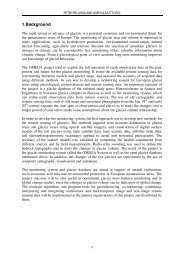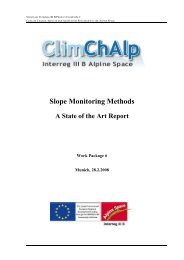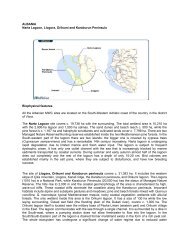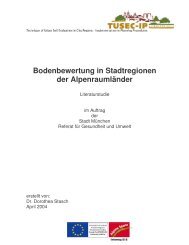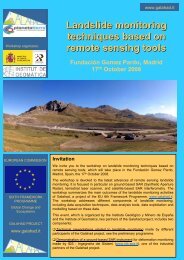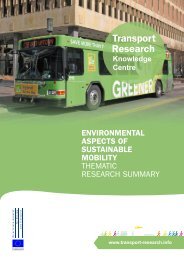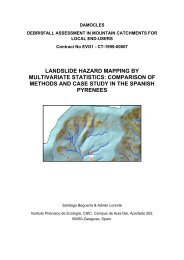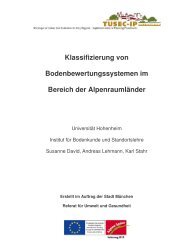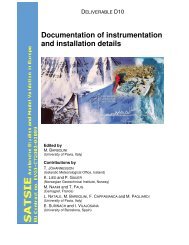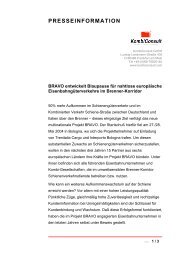Deliverable D3.1.2 Key products of the forest-based industries and ...
Deliverable D3.1.2 Key products of the forest-based industries and ...
Deliverable D3.1.2 Key products of the forest-based industries and ...
You also want an ePaper? Increase the reach of your titles
YUMPU automatically turns print PDFs into web optimized ePapers that Google loves.
<strong>Key</strong> <strong>products</strong> <strong>of</strong> <strong>the</strong> <strong>forest</strong>-<strong>based</strong> <strong>industries</strong><strong>and</strong> <strong>the</strong>ir dem<strong>and</strong>s on wood raw material propertiesBasic properties common for several paper <strong>products</strong>Paper is basically a network <strong>of</strong> fibres. The properties <strong>of</strong> a paper are determined by <strong>the</strong> properties <strong>of</strong><strong>the</strong> fibres, <strong>the</strong> structure <strong>of</strong> <strong>the</strong> network <strong>and</strong> <strong>the</strong> character <strong>of</strong> <strong>the</strong> bonds between <strong>the</strong> fibres. It is alsoinfluenced by materials added to <strong>the</strong> network to improve specific properties or to reduce costs, suchas starch <strong>and</strong> fillers. Very <strong>of</strong>ten, paper is produced from mixtures <strong>of</strong> pulps <strong>and</strong> o<strong>the</strong>r materials <strong>and</strong><strong>of</strong>ten in multiple layers, where each layer shall have its specific properties to contribute to <strong>the</strong>properties <strong>of</strong> <strong>the</strong> engineered composite <strong>and</strong> to reduce costs. A good example <strong>of</strong> this is multi-ply paperboard, which has to be stiff (shall not bend easily). The solution is to use two surface layers with hightensile stiffness <strong>and</strong> to separate <strong>the</strong>se surfaces with material <strong>of</strong> lower density <strong>and</strong> cost. The materials<strong>of</strong> <strong>the</strong> different layers are selected <strong>and</strong> processed to fulfil <strong>the</strong> requirements for runability <strong>and</strong> o<strong>the</strong>rproperties at <strong>the</strong> lowest possible cost.For all types <strong>of</strong> paper, certain strength properties have to be fulfilled for acceptable runability on <strong>the</strong>paper machine, in printing presses <strong>and</strong> o<strong>the</strong>r converting equipments <strong>and</strong> for <strong>the</strong> expected functionalityby <strong>the</strong> end user. Different levels <strong>of</strong> strength <strong>and</strong> types <strong>of</strong> mechanical <strong>and</strong> fracture properties (tensile,tear, delamination, puncture, etc.) are relevant depending on <strong>the</strong> final product. The stiffness <strong>and</strong>dimensional stability is important for many <strong>products</strong>. Surfaces need to stay flat <strong>and</strong> packagingmaterials need to remain rigid, even with reasonable humidity variations, while o<strong>the</strong>r <strong>products</strong> need tobe somewhat elastic to absorb sudden loads.The structure <strong>of</strong> <strong>the</strong> fibre network is also important <strong>and</strong> particularly its evenness/homogeneity. Onlylimited variations in sheet grammage, g/m 2 , (formation) <strong>and</strong> thickness or density are acceptable.O<strong>the</strong>rwise <strong>the</strong> paper can not be optimally used. Local deviations may also initiate breaks. High bulk(low sheet density) is sometimes appreciated to save material (for instance in <strong>the</strong> mid-layer <strong>of</strong> paperboard in <strong>the</strong> example above) <strong>and</strong> for porosity. Porosity <strong>and</strong> surface properties <strong>of</strong> <strong>the</strong> paper are alsoimportant, for instance for printing, absorption, coating, lamination <strong>and</strong> tactile properties.Nowadays, most types <strong>of</strong> paper <strong>products</strong> carry printed information, which brings dem<strong>and</strong>s not only onsurface properties as mentioned above but also on optical properties like light scattering, uniformappearance, etc.Important properties <strong>of</strong> fibres in relation to paper propertiesThe dimensions <strong>of</strong> <strong>the</strong> fibres (length, width <strong>and</strong> wall thickness) are important in <strong>the</strong>mselves, especially<strong>the</strong> fibre length <strong>and</strong> fibre wall thickness. A number <strong>of</strong> relationships between fibre length, width <strong>and</strong> wallthickness are also very important in papermaking <strong>and</strong> for <strong>the</strong> properties <strong>of</strong> <strong>the</strong> <strong>products</strong>. Below, someimportant fibre properties are listed. Their level <strong>of</strong> importance depends on <strong>the</strong> product <strong>and</strong> processesused:• Fibre length• Fibre wall thickness• Fibre coarseness (g/km fibre), defined by fibre width <strong>and</strong> wall thickness (<strong>and</strong> process yield)• Number <strong>of</strong> fibres/g, defined by fibre length, width <strong>and</strong> wall thickness (<strong>and</strong> process yield)9




